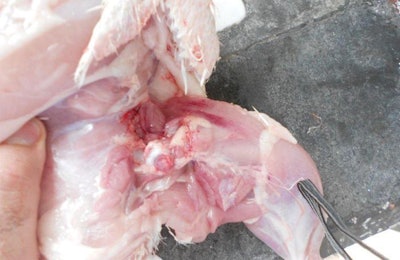
Treating broilers humanely at pre-slaughter and processing can improve bird welfare and allow poultry businesses to better align with client expectations and increase yields. Good attention to broiler welfare makes good business sense.
Poorly treated birds will suffer and yields may fall, but it is also worth remembering that, with social media now so easily accessible, failure to respect broilers’ welfare needs can be quickly and easily filmed and broadcast -- and this can have far greater business implications.
There are, however, several key points during pre-slaughter and processing where following good practice can be to the benefit of birds and the business alike.
Pre-slaughter
1. Good capture practice. Capturing birds by the body while keeping their wings close has been shown to be best method of capture. However, even when using this method, care must be taken not to squeeze the birds, as this can constrict the abdominal air sacks that form part of the respiratory system, resulting in pain and suffering.
Broilers should never be caught and carried by the legs. Turning the birds roughly through 180 degrees can dislocate the femur from the pelvis. This causes pain for the broiler, and can result in bruising, lowering meat quality.
Capturing birds in this way can also rupture the tendon next to the gastrocnemius muscle, again causing pain and bruising. Dislocation of the bones in the lower leg may occur with the tibia separating from the fibula at the foot, again causing pain.
Birds captured and carried by the legs will flap their wings in an attempt to escape. This intense flapping can break the thorax bones due to the excessive pressure exerted by the pectoral muscles. As in the above instances, the result will be pain, bruising and poorer quality meat.
2. Quality caging. Using good quality cages or crates is a necessity, although one that it is too often ignored.
Cages should not be broken or split, and they must have lids. Splits and damage can harm the birds, and missing lids can lead to trauma to the head and death. If lids are missing, during loading birds may poke their heads or other body parts out and these can become trapped, leading to pain, bleeding, and even death.
3. Considerate loading and transport. If the forklift trucks used to load the cages onto the trucks create a lot of noise, broilers' stress levels will rise, as they have only ever known the quiet of the grow-out house.
Consequently, their natural fight-or-flight reaction will lead to blood being pumped to the wings and legs. High noise levels may also be detrimental to those operators engaged in loading the trucks. Electric, rather than diesel forklifts may be preferred.
Irrespective of season, it is important to properly control the climate within the trucks shipping birds to the processing plant. The truck’s microclimate needs to be monitored in real time throughout the journey to enable the volume of air entering it to be adjusted as necessary, so preventing critical stress conditions.
Birds must be kept comfortable and treated with respect while waiting to be slaughtered. If not, stress levels will rise.
At the processing plant
4. Keep noise to a minimum. Too much noise at unloading will have the same negative effects on birds as too much at loading, i.e. they will become stressed and blood will flow to the wings and legs.
However, at this stage, there may not be time for blood distribution in the body to return to normal as birds may not have time to calm down. This will mean that when carcasses exit the last plucker, the wings and thighs are likely to have a reddened appearance.
5. Careful hanging on the overhead conveyor. Birds should be hung with care and their legs not forced into the shackles. Forcing the legs into the shackles will result in pain, and can lead to leg breaks. In many plants, broken legs result in rejects.
6. Good feed withdrawal. Feed withdrawal is often overlooked from a welfare point of view, but poor feed withdrawal can affect broiler welfare at slaughter.
Should birds arrive at the processing plant with feed still in the digestive tract, due to the forces of gravity and the fact that birds do not have a diaphragm, when they are hung on the shackles the intestines will exert pressure on the respiratory tract, making breathing more difficult.
While this is unpleasant for the bird, there are also practical implications in that the bird will flap its wings in an attempt to escape, and this can result in damage and so increase the number of rejects.

Poor feed withdrawal can make breathing difficult for birds during the slaughter process, but also result in rejected carcasses.
Ensuring chicken welfare at processing
















